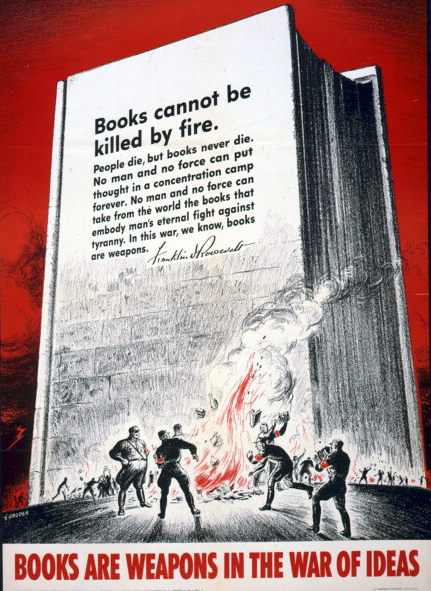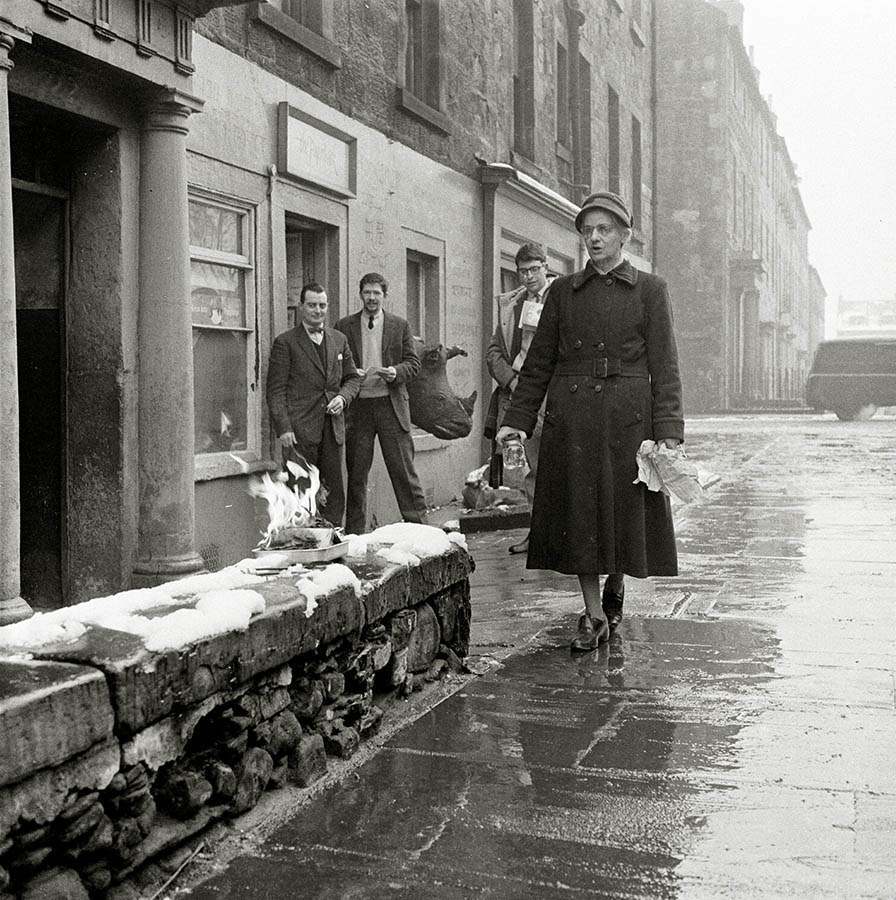Who burns books?
In 1880 the printer and bibliographer William Blades published The Enemies of Books. They were: “Fire, Water, Gas and Heat, Dust and Neglect, Ignorance, The Bookworm, Other Vermin, Bookbinders, Collectors & Servants and Children.”
His section of ‘Ignorance’ tells the reader:
Bigotry has also many sins to answer for. The late M. Muller, of Amsterdam, a bookseller of European fame, wrote to me as follows a few weeks before his death:—
“Of course, we also, in Holland, have many Enemies of books, and if I were happy enough to have your spirit and style I would try and write a companion volume to yours. Now I think the best thing I can do is to give you somewhat of my experience. You say that the discovery of printing has made the destruction of anybody’s books difficult. At this I am bound to say that the Inquisition did succeed most successfully, by burning heretical books, in destroying numerous volumes invaluable for their wholesome contents. Indeed, I beg to state to you the amazing fact that here in Holland exists an Ultramontane Society called ‘Old Paper,’ which is under the sanction of the six Catholic Bishops of the Netherlands, and is spread over the whole kingdom. The openly-avowed object of this Society is to buy up and to destroy as waste paper all the Protestant and Liberal Catholic newspapers, pamphlets and books, the price of which is offered to the Pope as ‘Deniers de St. Pierre.’ Of course, this Society is very little known among Protestants, and many have denied even its existence; but I have been fortunate enough to obtain a printed circular issued by one of the Bishops containing statistics of the astounding mass of paper thus collected, producing in one district alone the sum of L1,200 in three months. I need not tell you that this work is strongly promoted by the Catholic clergy. You can have no idea of the difficulty we now have in procuring certain books published but 30, 40, or 50 years ago of an ephemeral character. Historical and theological books are very rare; novels and poetry of that period are absolutely not to be found; medical and law books are more common. I am bound to say that in no country have more books been printed and more destroyed than in Holland. W. MULLER”…
From the Church of Rome to the Church of England is no great leap, and Mr. Smith, the Brighton bookseller, gives evidence thus:
“It may be worth your while to note that the clergy of the last two centuries ought to be included in your list (of Biblioclasts). I have had painful experience of the fact in the following manner. Numbers of volumes in their libraries have had a few leaves removed, and in many others whole sections torn out. I suppose it served their purpose thus to use the wisdom of greater men and that they thus economised their own time by tearing out portions to suit their purpose. The hardship to the trade is this: their books are purchased in good faith as perfect, and when resold the buyer is quick to claim damage if found defective, while the seller has no redress.”
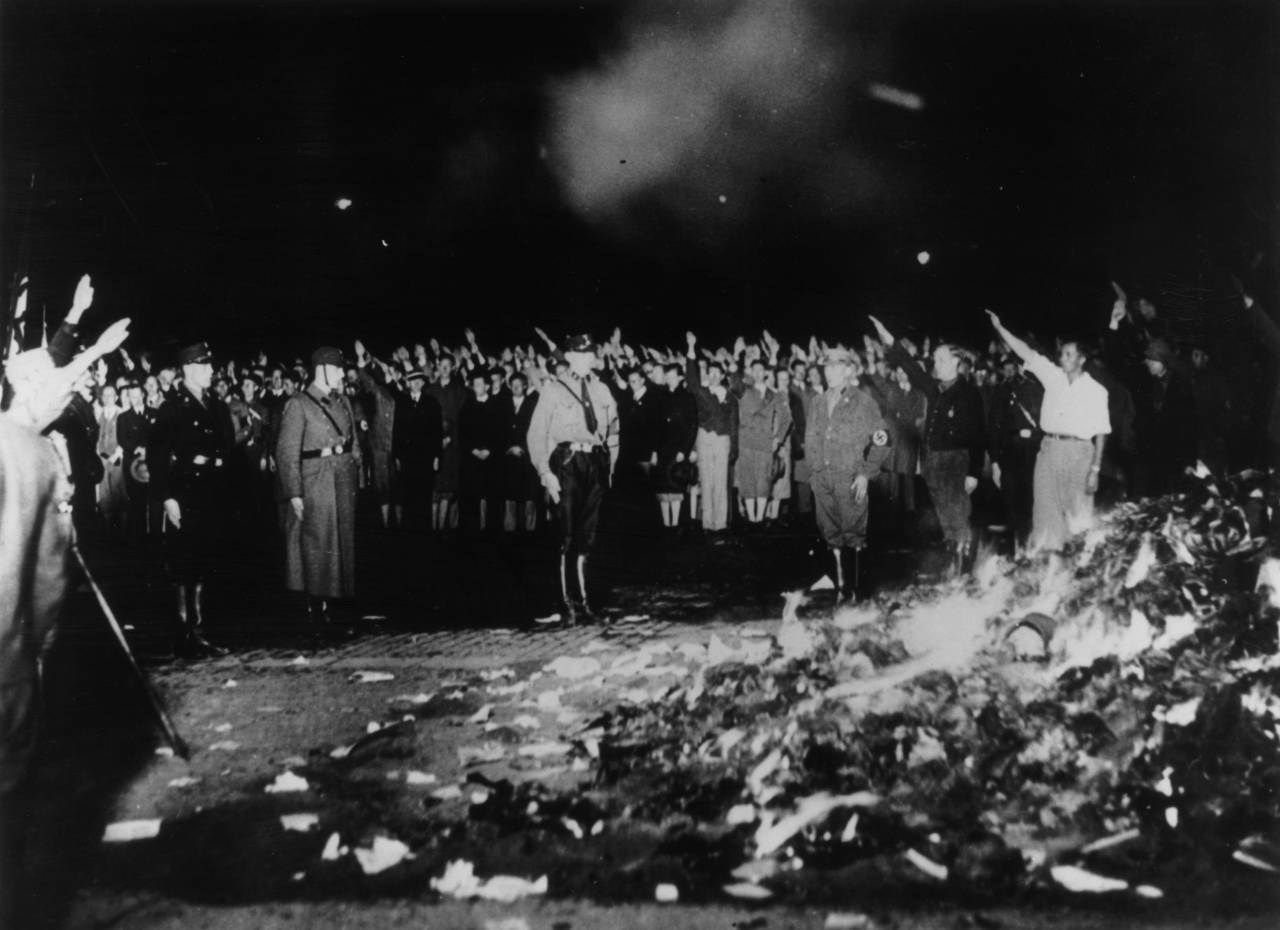
May 1933: German soldiers and civilians give the Nazi salute as thousands of books smoulder during one of the mass book-burnings implemented throughout the country to destroy non-Aryan publications. (Photo by Keystone/Getty Images)
We know that the Nazis burnt books.
On April 6, 1933, the Nazi German Student Association’s Main Office for Press and Propaganda proclaimed a nationwide “Action against the Un-German Spirit,” to climax in a literary purge or “cleansing” (Säuberung) by fire. Local chapters were to supply the press with releases and commissioned articles, offer blacklists of “un-German” authors, sponsor well-known Nazi figures to speak at public gatherings, and negotiate for radio broadcast time. On April 8 the students’ association also drafted its twelve “theses”—a deliberate evocation of Martin Luther’s 95 Theses: declarations which described the fundamentals of a “pure” national language and culture. Placards publicized the theses, which attacked “Jewish intellectualism,” asserted the need to “purify” the German language and literature, and demanded that universities be centers of German nationalism. The students described the “action” as a response to a worldwide Jewish “smear campaign” against Germany and an affirmation of traditional German values.
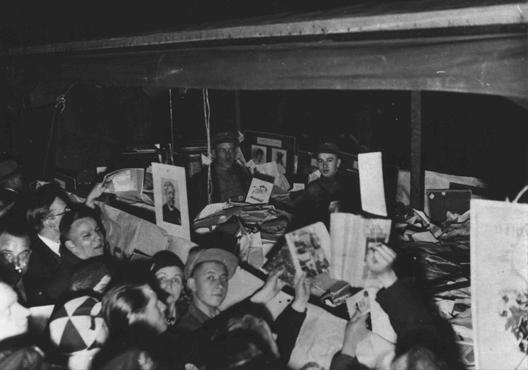
German students gather around books they regard as “un-German.” The books will be publically burned at Berlin’s Opernplatz. Berlin, Germany, May 10, 1933.
— National Archives and Records Administration, College Park, Md.
In a symbolic act of ominous significance, on May 10, 1933, university students burned upwards of 25,000 volumes of “un-German” books, presaging an era of state censorship and control of culture. On the evening of May 10, in most university towns, right-wing students marched in torchlight parades “against the un-German spirit.” The scripted rituals called for high Nazi officials, professors, university rectors, and university student leaders to address the participants and spectators. At the meeting places, students threw the pillaged and “unwanted” books onto bonfires with great ceremony, band-playing, and so-called “fire oaths.” In Berlin, some 40,000 persons gathered in the Opernplatz to hear Joseph Goebbels deliver a fiery address: “No to decadence and moral corruption!” Goebbels enjoined the crowd. “Yes to decency and morality in family and state! I consign to the flames the writings of Heinrich Mann, Ernst Gläser, Erich Kästner.”
As the books burnt, Goebbels spoke:
“The era of extreme Jewish intellectualism is now at an end…. And thus you do well in this midnight hour to commit to the flames the evil spirit of the past. This is a strong, great and symbolic deed – a deed which should document the following for the world to know – Here the intellectual foundation of the November Republic is sinking to the ground, but from this wreckage the phoenix of a new spirit will triumphantly rise”
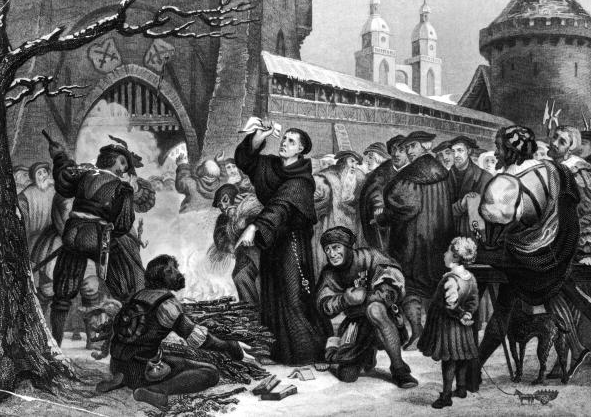
Circa 1518, Martin Luther standing before a fire with the work of Johann Tetzel in his hand. Tetzel and Luther wrote theological works arguing with the other’s cause, resulting in the public burning of each other’s work
The reference to Luther was apt:
In 1817, German student associations (Burschenschaften) chose the 300th anniversary of Luther’s 95 Theses to hold a festival at the Wartburg, a castle in Thuringia where Luther had sought sanctuary after his excommunication. The students, demonstrating for a unified country—Germany was then a patchwork of states—burned anti-national and reactionary texts and literature which the students viewed as “Un-German.”
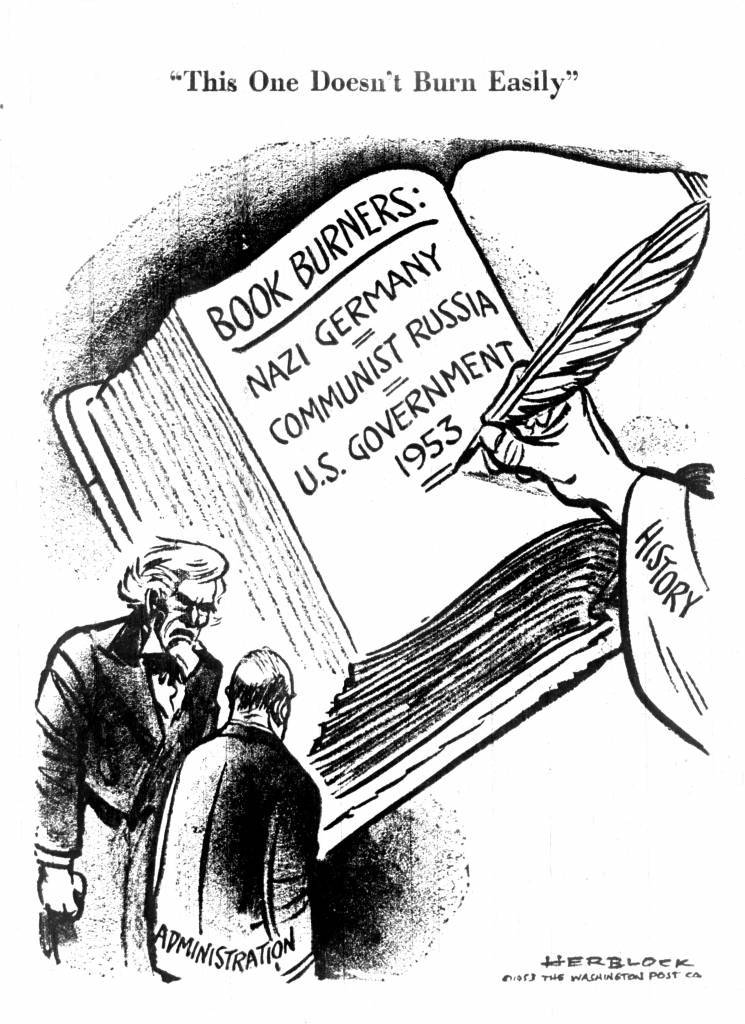
Herblock, “This One Doesn’t Burn Easily,” Washington Post, June 18, 1953.–US Holocaust Memorial Museum/Library of Congress
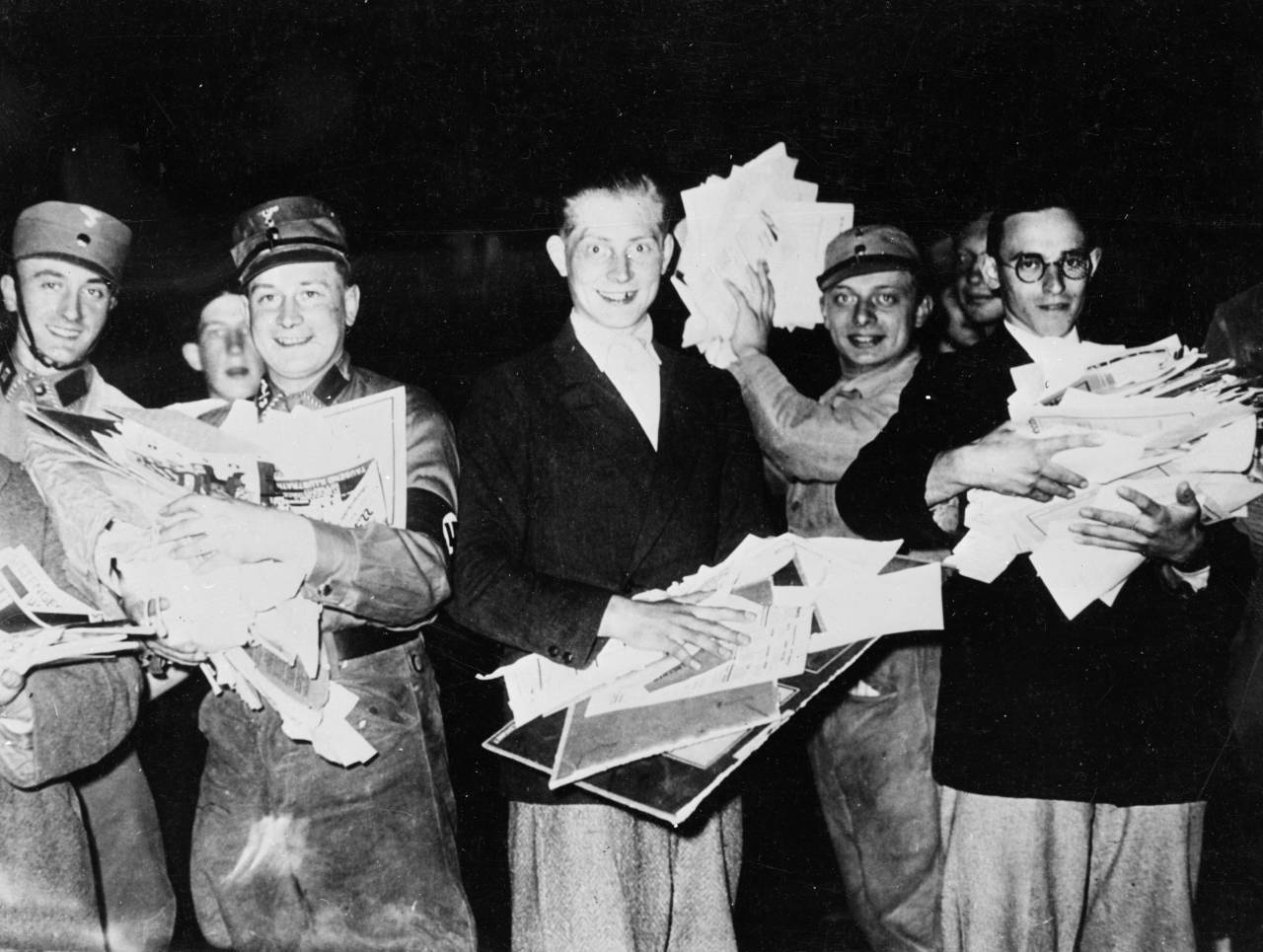
A group of Nazi troops and students gather seized papers and books to burn, in the Opernplatz, Berlin. (Photo by Keystone/Getty Images)
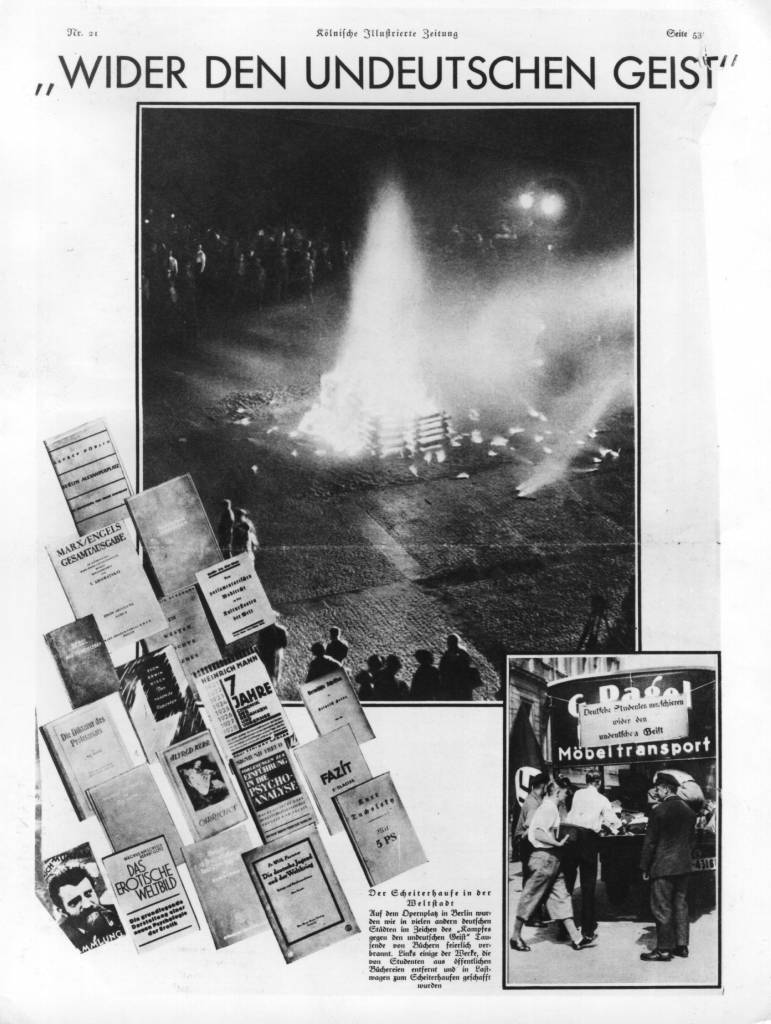
May 1933: An advertisement showing the burning of communist and Jewish books, branded as offensive, in the ‘struggle against anti-German feeling’, at the Operaplace, Berlin. (Photo by Hulton Archive/Getty Images)
The censorsious, totalitarian and bigotted try to destory ideas by fire. The Spanish Inquisition, The Taliban, ISIS and other groups united by intolerance burn books they declare subversive and against the orthodoxy.
Books are Weapons in the War of Ideas’: 1942 US World War II Anti-German poster showing Nazis burning books and quoting F D Roosevelt, ‘Books cannot be killed by fire’.
“Don’t think you’re going to conceal faults by concealing evidence that they ever existed. Don’t be afraid to go in your library and read every book, as long as any document does not offend our own ideas of decency. That should be the only censorship.
“How will we defeat communism unless we know what it is, what it teaches, and why does it have such an appeal for men, why are so many people swearing allegiance to it? It’s almost a religion, albeit one of the nether regions.
“And we have got to fight it with something better, not try to conceal the thinking of our own people. They are part of America. And even if they think ideas that are contrary to ours, their right to say them, their right to record them, and their right to have them at places where they’re accessible to others is unquestioned or it’s not America” —Dwight David Eisenhower
Often people who burn books are people who have read one book and thought it right absolutely.
The poet, philosopher and political theorist John Milton, whose books were publicly burned in England and France, gives perhaps the best explanation of why authorities down the centuries have seen danger in certain books. “Books are not absolutely dead things,” he wrote in his celebrated attack on censorship, Areopagitica, in 1644, “but do contain a potency of life in them to be as active as that soul was whose progeny they are.” Anyone who kills a man, Milton said, kills “a reasonable creature, God’s image; but he who destroys a good book kills reason itself”.
The Scottish Review, recalls a book burning in 1960s England. Not everyone was swinging in the Sixties. One woman was unimpressed with what she found for sale in Edinburgh’s Paperback Bookshop run by American-born Jim Haynes in the decade of decadence:
During the Paperback Bookshop reign, it was the scene of the burning of ‘Lady Chatterley’s Lover’ which had been stopped by Penguin. One day a severe-looking Edinburgh matron entered the shop and asked Jim if he could ‘acquire’ a copy for her. He told her to return in two days. Meanwhile, he alerted a photographer friend to be on hand with the camera. On the agreed day she arrived carrying a pair of coal tongs. Paying for the book, she picked it up with the tongs and carried it outside as if it was vermin. Jim and friend quickly followed to find her dousing the book in kerosene. Soon it was alight and off she ran into the sunset.
Penguin Books was put on trial in 1960 for publishing the book, in what became a test-case for freedom of speech. The book was approved. An Old Bailey jury found that it was not obscene.

7th February 1964: Obscene books litter the floor of a shed at London docks waiting for incineration after being confiscated by Customs. (Photo by Keystone/Getty Images)
“Books are sacred to free men for very good reasons. Wars have been fought against nations which hate books and burn them. If you are an American, you must allow all ideas to circulate freely in your community, not merely your own”
— Kurt Vonnegut
The practice features prominently in two of the 20th century’s more alarming novels about authoritarian future societies: Ray Bradbury’s Fahrenheit 451, in which book-burning has become institutionalised in a wholly hedonistic, anti-intellectual US, and George Orwell’s Nineteen Eighty-Four, where unapproved books and tracts are consumed by flames in a “memory hole”. It also crops up in the Bible. A passage in the New Testament Book of Acts (Acts 19: 19-20) suggests Christian converts in Ephesus burned books of “curious arts”, generally taken to mean traditional magic: “Many of them also which used curious arts brought their books together and burned them before all men.”
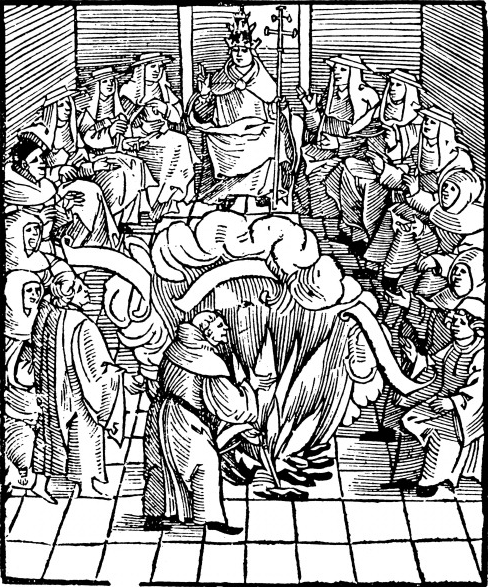
Pope Leo X (Giovanni de’ Medici 1475-1521, Pope from 1513) supervising the burning of Martin Luther’s books after the first Diet of Worms, 1521. Woodcut.
The earliest recorded incident of book-burning in history appears, however, to be Emperor Qin Shi Huang’s order in 213 BC that all books of philosophy and history from anywhere other than Qin province in China be burned (and a large number of uncooperative intellectuals buried alive). Since then, the Ancient Greeks and Romans have burned Jewish and Christian scriptures, and any number of popes from the 13th to the 17th centuries ordered the burning of the Talmud, a fate that befell John Wycliffe’s works in the 15th century and William Tyndale’s English translation of the New Testament in the 16th.
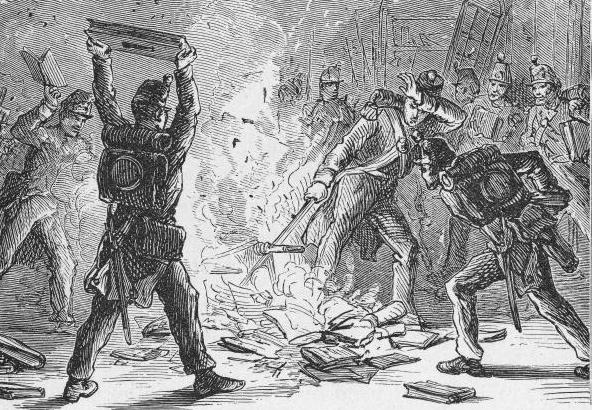
Illustration of British soldiers burning books in piles within the U.S. Library of Congress, Washington, D.C., circa 1814.
The Spanish Inquisition burned 5,000 Arabic manuscripts in Granada in 1499, and Spanish conquistadors burned all the sacred texts of the Maya in 1562. Luther’s translation of the Bible went up in flames in Catholic parts of Germany in the 1640s, and in the 1730s the Archbishop of Salzburg oversaw the burning of every Protestant book and Bible that could be got hold of. The communists burned untold numbers of decadent western books and writings in the Soviet Union from the 1920s on, and several American libraries burned the works of supposedly pro-Communist authors during the McCarthy era.
And now? Well, it’s not so easy, says one cartoonist:
No. It’s easier. Because in a paperless society, you need power to read, literally…
Would you like to support Flashbak?
Please consider making a donation to our site. We don't want to rely on ads to bring you the best of visual culture. You can also support us by signing up to our Mailing List. And you can also follow us on Facebook, Instagram and Twitter. For great art and culture delivered to your door, visit our shop.



